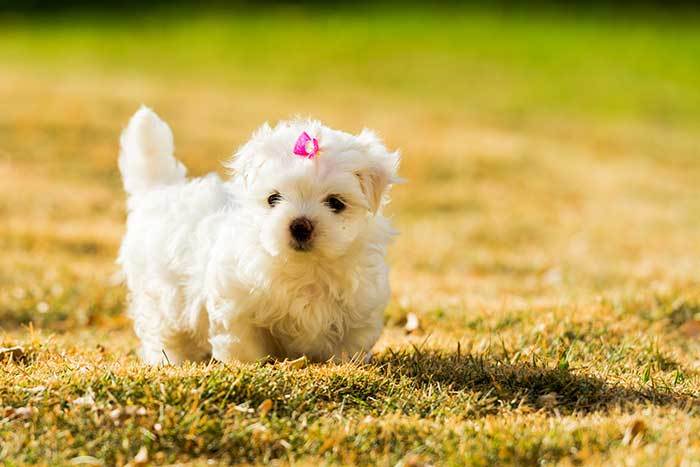The Teacup Maltese is one of the most adorable breeds around, and with their cute white fur and overall looks, they have won the hearts of many dog lovers the world over.
Also known as the Miniature Maltese, Mini Maltese or Toy Maltese, the breed’s gentleness, sociability and cute-looking coat are sure to endear this dog to many people.
Some dog breeders are constantly trying to create smaller dogs in order to meet the demand of dog lovers looking for smaller versions of their favorite breeds. This is because many people think that a smaller dog is much easier to take care of and carry around.
These little doggies can be carried in a handbag and you can find many pictures of celebrities carrying their cute pets in this manner.
When you have a sweet bundle of fluff, you are likely to fall in love with him and simply want to be around them all day long.
But what do you know about owning a Teacup Maltese? Read on to see picture and learn everything there’s to know about these loving bundles of fur and fun!
Table of Contents
What Exactly Is a Teacup Maltese?
Some dog owners call the dog Miniature Maltese, Mini Maltese, or Toy Maltese.
Each name refers to the tiny-sized Maltese. Still, Teacup Maltese it the most common term most dog lovers use when talking about this dog.
Keep in mind that miniature, mini, toy or any other alternative name people use does not mean that the dog is a separate and unique breed. These terms more or less refers to Maltese dogs that are simply smaller in size than the standard Maltese dogs.
View this post on Instagram
The History of the Teacup Maltese Breed
The origin of the Maltese breed of dogs dates back to around two millennia.
The breed was first documented in major works of art, poetry and literature during the ancient popular cultures of Greece, Rome and Egypt with mentions by Aristotle himself.
Maltese dogs were highly cherished by the ancient Egyptians, who had representations of the dog on historic artifacts.
The Greeks, on the other hand, erected tombs for their Maltese-like dogs. The Egyptians and many Europeans believed that the Maltese had the power to cure certain diseases and would often put one near the pillow of a sick person. That’s why the dog was once nicknamed “The Comforter”.
Despite his historic prominence, it is not clear where the Maltese breed actually came from. Some historians claim that the breed was created in Malta from spitz or spaniel-like dogs. Others believe that the breed was developed from ancient Tibetan terriers from Asia.
Both of these ancestors are bigger dogs. Therefore, like many other toy breeds today, years of development reduced the size of the dog and certainly changed the coat color to white.
View this post on Instagram
Regardless of his antecedents, evidence has shown that the Maltese dogs were prominent on the island of Malta. As the name Maltese suggests, these dogs were named after this beautiful island off the coast of Italy.
Other names that have been previously used to refer to the Maltese include the Maltese Lion Dog and the Roman Ladies Dog.
Historians believe that trading prompted the distribution of the breed to other parts of the world. As more and more traders began to take these dogs home with them, their popularity grew rapidly.
Once the breed made its way into Europe and subsequently Egypt, the Maltese became truly prominent.
[thrive_leads id=’7777′]When the Maltese made its way to the UK in the 1500s, only the richest people could afford to own this dog. Having a Maltese at home was regarded as a symbol of stature and grandness.
Over the next few centuries, the breed was refined further by mixing these dogs with miniature spaniels and light-colored poodles .
Although it is not possible to pinpoint the exact breeds used, it is believed that the tan and lemon patterns that the Maltese dog can hold are because of the poodle color genes.
View this post on Instagram
The Maltese breed eventually made its way to the United States in the 1800s.
In 1888, the Maltese breed was officially recognized by the AKC along with six other breeds, namely the Dalmatian, Pomeranian, the Old English Sheepdog, the Japanese Chin, the Welsh terrier and the Airedale Terrier.
The Teacup Maltese was first witnessed in the seventeenth and eighteenth centuries, when breeders were trying to make this small dog even smaller.
Over time, the breed standard was established and finalized in 1964 and this has not changed ever since.
[thrive_text_block color=”note” headline=””]ALSO READ: What Breed is My Dog? How to Identify Your Dog’s Breed? [/thrive_text_block]Now that you know where the Teacup Maltese came from, let’s now briefly talk about the physical characteristics of these little dogs.
General Appearance
The Teacup Maltese is a very tiny dog. According to the breed standard, this tiny Maltese comes in color white only. All the other colors (including the bi and tri-colored dogs) have not yet been accepted.
The Teacup Maltese dog is easily identifiable by his rounded face, black eyes and black nose.
View this post on Instagram
A full grown Miniature Maltese reaches a height of around 8 inches and weighs an average of 4 to 5 pounds. Males and females usually do not differ greatly in size or weight.
Keep in mind that a Toy Maltese dog is regarded as a Toy Maltese only when he attains his maximum size as a full grown dog.
[thrive_text_block color=”note” headline=””]ALSO READ: All About the Chorkie (Chihuahua Yorkie mix) [/thrive_text_block]Teacup Maltese Behavior & Temperament
The Teacup Maltese is a very sweet and loving dog. He has a lot of energy and loves to play around.
They are also known to be great companion dogs. They love the outdoors and may try to jump and chase, especially when excited.
Since they are very small, they love sitting on their owner’s lap in the evenings. For that reason, the Teacup Maltese dogs are commonly known to be lapdogs who enjoy attention and spending time with their owners.
They also enjoy cuddling near humans and also tend to follow their owners around the house.
View this post on Instagram
The Teacup Maltese is also known to be very alert. He is wary of strangers and will alert their owner immediately he sees one, making him an excellent little watchdog.
These tiny Maltese dogs are ideal for small-space living. Many people who live in apartments or small units tend to love their dogs due to their small size. This makes the tiny Maltese ideal for anyone who lives in the inner city or small rural homes.
These miniature Maltese pups are also very lively and playful. Children simply love their hardy and vigorous traits.
? However, keep in mind that small kids can unintentionally harm a small dog like the Teacup Maltese. They can handle them roughly, which can hurt them or even break their fragile bones.
View this post on Instagram
Therefore, it is very important to ensure that your Teacup Maltese puppy is safe around children and for that reason, they are best suited to homes with older children who know how to play with small dogs without manhandling them.
Alternately, you should teach your children how to pick up and carry your Maltese puppy. It is important to note here that kids and dogs should never be left alone together without the supervision of an adult.
View this post on Instagram
The Teacup Maltese is charming and dignified in his actions. His friendliness makes him a wonderful companion. He can also mix with other pets and animals without anyone problem.
However, make sure to expose your puppy to different people and sounds to prevent them from becoming fearful or shy. These tiny pups are a bit more skittish and vigilant compared to their bigger counterparts.
Proper socialization will help make your pup more confident, calm, and happy around other pets and animals!
[thrive_leads id=’12402′]Teacup Maltese Training
As with other small dogs, housetraining a Teacup Maltese can be a challenging task.
This is because the Teacup Maltese dogs are known to be quite stubborn. With consistent care and effort, however, you can train them to use a litter box or even go outside.
Since Teacup dogs are easily vulnerable to separation anxiety, make sure that you or someone else will be available to attend to them.
Teacup Maltese dogs also tend to bark a lot and should be trained to remain quiet to keep them from becoming a nuisance to your neighbors.
With their high intelligence levels, the Mini Maltese tends to do well in obedience training and performing tricks. Be sure to use lots of positive reinforcement when training your Maltese, but remember to be firm and consistent to show your dog that you are the pack leader.
? Never over-pamper your mini Maltese puppy, as they may be prone to small dog syndrome, which is an undesirable behavioral issue.
[thrive_text_block color=”note” headline=””]LEARN ABOUT IT: 6 Tips to Stop Your Dog from Peeing in the House [/thrive_text_block]Exercise Needs
The full grown Teacup Maltese enjoys playing outside and going out on regular walks. They are naturally playful even as adults.
View this post on Instagram
Teacup Maltese dogs are also active indoors, so there’s no need to engage them in intense physical activities to keep them physically fit.
? In fact, owners should wait until their puppies are mature and their bones are strong enough (around eight months) to take them out for short walks outside.
Before this time, however, walking and other exercises are possible. You should allow your Mini Maltese puppy to play their favorite games at a reasonable pace until your little munchkin grows up to be a full-grown dog .
View this post on Instagram
Before indulging your puppy into any intense physical activities, you should take him to your vet for a checkup to ensure their bones are strong and healthy enough to play and take part in exercises.
Maltese dogs are fond of chewing on anything and everything they can get their little jaws on. This isn’t entirely their fault; they are most likely teething – which is a pretty painful experience in their little lives.
Providing your puppy with appropriate chew toys can be a great way to ease their frustration and save your shoes, furniture, and other valuable items that he shouldn’t be eating!
[thrive_text_block color=”note” headline=””]LEARN ABOUT IT: 8 Tips to Stop a Dog from Chewing [/thrive_text_block]Is a Teacup Maltese Hypoallergenic?
This is an important question to ask, especially if someone in your family is allergic to pet dander or hair.
Yes, the Teacup Maltese is said to be a hypoallergenic breed. These dogs shed less dander compared to other breeds and that’s why they are considered hypoallergenic.
View this post on Instagram
However, even hypoallergenic dog breeds produce dander and hence, can cause an allergic reaction.
However, the Teacup Maltese, with its soft and silky coat of hair, will most likely cause fewer problems than a pup with a thick coat of fur.
Teacup Maltese Grooming Needs
The Maltese dog has a long, soft and silky coat. This is one of the reasons why many dog owners love this breed so much. However, this is not a dog you can afford to ignore when it comes to grooming.
Brush your Mini Maltese each day, and have his hair cut regularly to enhance comfort and ensure ease of maintenance.
View this post on Instagram
Most Mini Malteses require a bath with quality dog-friendly shampoo at least once a month. Deodorizing wipes for dogs are a major plus as they help remove bad odor and keep your dog smelling fresh.
Clean your pup’s mouth and eyes daily. With a warm soft washcloth, wipe the area around his mouth after eating and wipe any discharge from his eyes.
Finally, brush your dog’s teeth regularly. Dental issues are quite common in Teacup Maltese dogs, so you must check his mouth regularly for any issues.
RELATED: 9 Tips To Clean A Dog Without A Bath
Teacup Maltese Feeding Information
Proper nutrition is important for maintaining the wellbeing and overall health of your furry friend. You need to choose high quality dog food for your Teacup Maltese dog.
The amount of food that you need to feed your Teacup Maltese will depend on his age, activity level and body metabolism.
The first two years in a dog’s life are vital in determining his overall well-being in adulthood,. The body and bones of a puppy grow at a rapid rate, dictating the need for the correct amount of vitamins, minerals and calories to feed him.
Growing puppies will require just 28 grams (1 ounce) to 42 grams (1.5 ounces) of dog food based on his weight just once per day.
Once your pup is 2 years old, he will require less food. Give your pup 14 grams (1/2 ounce) of dry food per body pound per day. It is a good idea to split the dog’s meal into a few smaller meals each day. An active Mini Maltese will require more food than usual.
For Maltese pups aged seven years and older, one meal is required along with fresh, healthy treats.
[thrive_text_block color=”note” headline=””]ALSO READ: The 10 Most Dangerous Human Foods for Dogs [/thrive_text_block]Teacup Maltese Lifespan and Health Issues
The average lifespan of a Teacup Maltese is around 12 to 15 years.
Sadly, these cute little dogs are prone to more health issues than a standard Maltese.
The most common conditions are hyperglycemia, heart problems, seizures, dental problems and fragile bones.
Not all Teacup Maltese dogs will suffer from any or all of these health problems, but it’s always best to familiarize yourself with them when looking to add one to your family.
When choosing a Teacup Maltese puppy, make sure you go through a reputable breeder who will show you the health clearances for both of your puppy’s parents.
View this post on Instagram
Finding a Healthy Teacup Maltese Puppy
If you have your heart set on owning a Teacup Maltese, you may need to look around to find a good breeder. Finding breeders that specialize in Teacup dogs can be difficult.
However, you can also find puppies or adult dogs at rescues and shelters listed for adoption.
So, if you’re having trouble finding Teacup Maltese puppies, check your nearby shelters or rescue organizations. Consider giving these dogs a home and check out a shelter or rescue group near you.
Once you find a Mini Maltese, make sure to get it tested for various health issues associated with this breed.
Ideally, you should also ask for the health clearances of both parent dogs.
[thrive_leads id=’10998′]How Much Is A Teacup Maltese?
To create a Teacup Maltese, you need to breed together two tiny Maltese dogs.
These dogs usually bare a maximum of three puppies, so one or two Teacup Maltese puppies will often be created for each litter. However, this would also put great strain on the mother.
This incredible level of strain on the mother means that quality health care is of the utmost importance.
These additional precautions imply that the price of Teacup Maltese puppies for sale is usually high. Expect to pay around $750 to $2,000 for one of these cute little puppies.
View this post on Instagram
What To Look For In A Breeder
Their popularity and the high price tag mean that Teacup Maltese are a favorite for puppy mills and pet stores.
These kinds of people are out to make a quick buck and do not always care about the wellbeing of their puppies. You can avoid such breeders if you look around and choose a reputable breeder.
A good breeder will carry out all the necessary health tests on the puppies and their parents. A reputable breeder will also be honest with you and answer any questions you may have in mind.
[thrive_text_block color=”note” headline=””]ALSO READ: All About The Maltese Shih Tzu Mix (Malshi) [/thrive_text_block]Conclusion
So there you have it, our guide to owning the teacup Maltese.
If you are interested in a small dog who will offer plenty of love and affection, then a Teacup Maltese might be the dog for you.
Their tiny size makes them a great choice for families or individuals with limited space.
Although the care and attention needed by your new Teacup Maltese puppy may seem a bit much, it will be more than worth it for the lucky owner!




